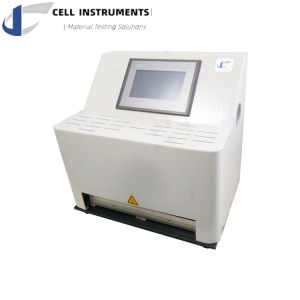Application
A Heat Seal Tester is a device used in the packaging industry to evaluate the heat-sealing properties of various materials, such as films, laminates, and other packaging components. The heat seal strength and integrity of these materials are crucial to ensure the quality and effectiveness of packaging for products like food, pharmaceuticals, electronics, and more.
The tester works by applying a certain heat and pressure to a sample of the material being tested for a certain time interval, simulating the conditions under which heat seals are formed in the packaging process. The heat, pressure, and time settings can be adjusted to mimic different sealing conditions, which allows manufacturers to determine the optimal parameters for achieving strong and consistent seals.
The term "gradient" in Gradient Heat Seal Tester refers to the ability of the device to create a controlled temperature gradient across the sealing area. A Gradient Heat Seal Tester can also be understood as a Multi-Station Heat Seal Tester, which means tests can be run at different temperature settings simultaneously. This reduces the waiting time between tests and increases the overall efficiency of the testing process.
Standard
ASTM F2029-16(2021) : Standard Practices for Making Laboratory Heat Seals for Determination of Heat Sealability of Flexible Barrier Materials as Measured by Seal Strength
Technical Features
The key to a heat seal tester is its stability and accuracy in time, temperature, and pressure. GHS-02 Gradient Heat Seal Tester's PLC control unit and HMI touch screen, ensure good sealing results with our state-of-art design, and it can realize five groups of sealing temperatures simultaneously.
1. Both the upper and lower jaws are made of aluminum and independently heated so that heat loss is maximumly eliminated in sealing and temperature smoothness is ensured.
2. First class P.I.D. (proportional integral derivative) temperature controller for optimal heating management.
3. Achieve accuracy with proximity and pressure sensor, ensuring controlled dwell time and sealing pressure.
4. Unform sealing pressure by the three-way guided sealing bar.
5. User protection designs, such as anti-scald front cover, manual and foot switch, etc.
6. Seal jaw customization available in terms of dimension, shape, and sealing surface/patterns.
7. More gradient temperatures of upper and lower heating can be customized.
8.Seamlessly connect through the RS 232 port and professional software (optional).
Main Parameters
Sealing Temp. Ambient~250℃
Temp. Gradient ≤20℃
Deviation ±0.2℃
Sealing Time 0.1S~9999H
Sealing Pressure 0.15~0.7 MPa
Seal Jaws(mm) U: 40*10 5PCS/L: 330 1PCS
Gas Input 0.7 MPa with Ф6 mm Pipe
Power AC 220V 50Hz
Test Process
Place a sample between two parallel heated sealing jaws with flat surfaces. When the required temperature reaches equilibrium, the upper seal jaw, driven by a gas cylinder, is pushed down to exert a certain pressure on the sample and remain for some time. When the preset sealing time ends, the upper sealing jaw returns to its original position and the whole heatsealability testing process finishes.
Heat Sealing Evaluation
The heatsealability can be further analyzed by seal continuity, typically measured by air-leak, dye , visual examination, microorganism or other technique.
Location : No. 5577 Gongyebei Rd, Licheng, 250109 Jinan,
Contact : Yang Yvette, +8618560733670









